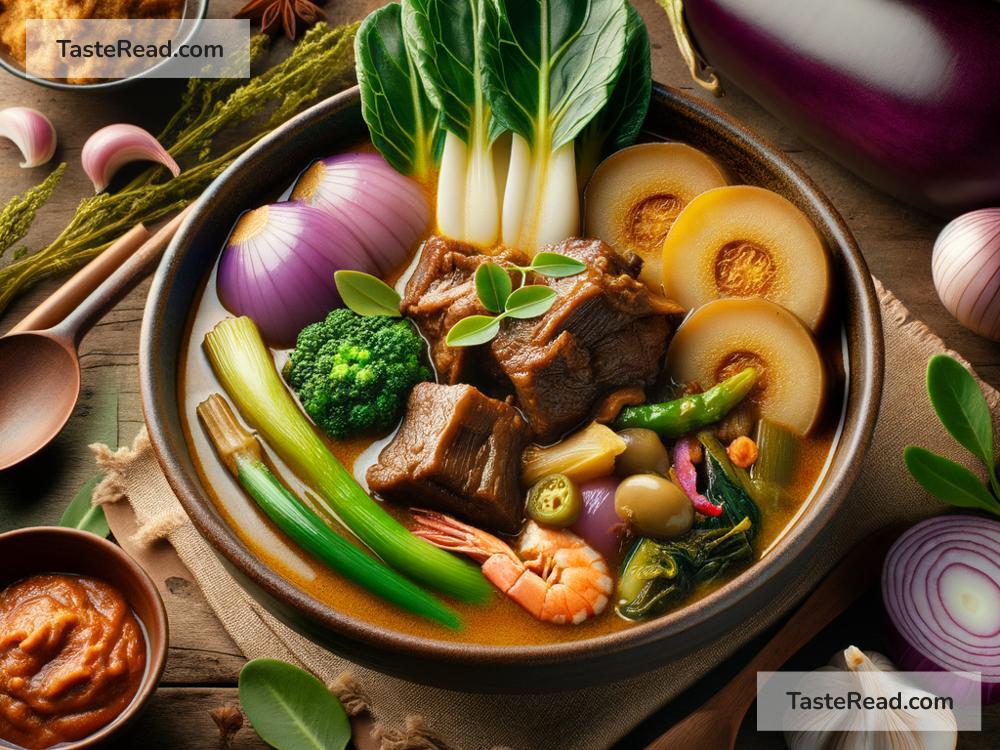Filipino cuisine is a dazzling array of flavors, textures, and colors that reflect the country’s rich cultural tapestry. Among its vast repertoire of comforting dishes, one particularly stands out for its unique taste, hearty ingredients, and soul-soothing qualities – the Kare-Kare. This Filipino stew is a true testament to the comforting power of food, offering more than just sustenance; it provides a warm embrace to anyone who has the pleasure of tasting it.
Kare-Kare is a dish that roots itself deeply in the heart of Filipino culinary tradition. At its core, it’s a peanut-based stew, typically made with oxtail, though variations might include pork hocks, calves feet, or just a medley of vegetables for those leaning towards a veggie-friendly version. The smooth, thick sauce is a blend of ground roasted peanuts or peanut butter, and toasted rice ground into a powder, giving Kare-Kare its signature earthy flavor and rich texture.
What truly sets Kare-Kare apart, making it a comforting stew, are its multifaceted layers of flavor and texture. The inclusion of native vegetables like eggplant, string beans, and banana blossoms, adds not only a splash of color but a variety of textures that make every spoonful an intriguing experience. The dish is traditionally simmered to perfection until the meat becomes fall-off-the-bone tender, melding perfectly with the vegetables and the thick sauce, creating a harmonious blend that is both luxurious and down-to-earth.
The comfort of Kare-Kare goes beyond its taste and ingredients. Its preparation and consumption are deeply ingrained in Filipino culture, often served during special occasions, family gatherings, and big celebrations. The act of preparing Kare-Kare is almost ritualistic, involving patience, care, and a lot of love. From the slow-cooking of the meat to the meticulous preparation of the sauce and vegetables, every step is a labor of love. This effort, combined with the communal nature of its consumption, often with friends and family, imbues the dish with a sense of warmth and comfort that can’t be found in any other dish.
Adding another layer to its comforting essence is its accompaniment, a salty shrimp paste called bagoong. The contrast between the stew’s creamy, subtle nuttiness and the bold, salty flavor of bagoong arouses the palate and enriches the overall dining experience. It’s this interplay of flavors that truly captivates ones soul, making each bite a reminder of home, tradition, and the simple joys of eating food that is made with utmost care and affection.
The emotional connection many Filipinos have with Kare-Kare is profound. For many, it brings back memories of childhood, of festive gatherings, and of the feeling of belonging and togetherness. It’s a dish that represents comfort in the sense of belongingness and identity, aligning perfectly with the Filipino values of familial ties and communal sharing. The delight of dunking a piece of tender oxtail or vegetable into the sauce, scooping it atop a warm bowl of rice, and sharing the moment with loved ones, is unmatched. It’s these moments that capture the essence of why Kare-Kare is more than just a stew, but a vessel of comfort, love, and shared heritage.
In today’s fast-paced world, where meals are often rushed and individualized, Kare-Kare stands as a beacon of traditional slow cooking and communal dining. Its preparation and consumption encourage people to take a step back, to invest time in cooking, and to gather around the dining table, sharing stories and creating memories. The comfort that Kare-Kare provides is an antidote to the hustle and bustle of modern life, offering a moment of solace and connection.
In conclusion, the Filipino Kare-Kare is a comforting stew not just for its hearty ingredients and delicious taste, but also for the emotional and cultural significance it holds. It embodies the Filipino spirit of community, the warmth of family, and the joy of sharing. Each serving of Kare-Kare is a reminder of home, of tradition, and of the comfort that comes from a meal cooked with love and enjoyed together. It’s a dish that transcends its culinary dimensions, providing comfort not only to the body but to the soul.


